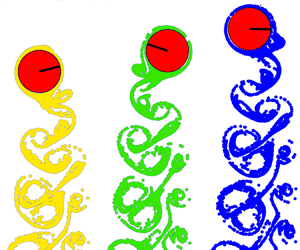Article contents
Asymptotic theory of a flapping wing of a circular cross-section
Published online by Cambridge University Press: 27 April 2022
Abstract

The paper is devoted to the study of the propulsive motion of a flapping wing of a circular cross-section performing translational–rotational oscillations in a viscous incompressible fluid. To describe the flow past the wing, the unsteady Navier–Stokes equation is solved. Using the method of asymptotic expansions for the case of small amplitudes of oscillations, an analytical solution of the problem is constructed in the first two terms. It is shown that the nonlinear interaction of time harmonics of translational and rotational oscillations causes secondary flows (steady streaming) that make the wing move in the direction perpendicular to the axis of translational oscillations. For the case of cruising motion, when the average hydrodynamic force acting on the wing is equal to zero, the dependence of the average speed on the dimensionless oscillation parameters is found. The results show that for relatively large angles of rotation the cruising speed of a flapping wing can be as high as the velocity amplitude of translational oscillations. The limits of applicability of the asymptotic theory are investigated using direct numerical simulations. Numerical data demonstrate that the theory well describes the flow past the wing in a wide range of dimensionless amplitudes, frequencies and angles of rotation. In conclusion, the efficiency of the propulsion system is evaluated. It is shown that in terms of relative energy consumption, a cylindrical flapping wing can be attributed to the most efficient propulsors in the range of Reynolds numbers  $Re \sim 10^2\text {--}10^3$.
$Re \sim 10^2\text {--}10^3$.
- Type
- JFM Papers
- Information
- Copyright
- © The Author(s), 2022. Published by Cambridge University Press
References
REFERENCES
- 12
- Cited by



